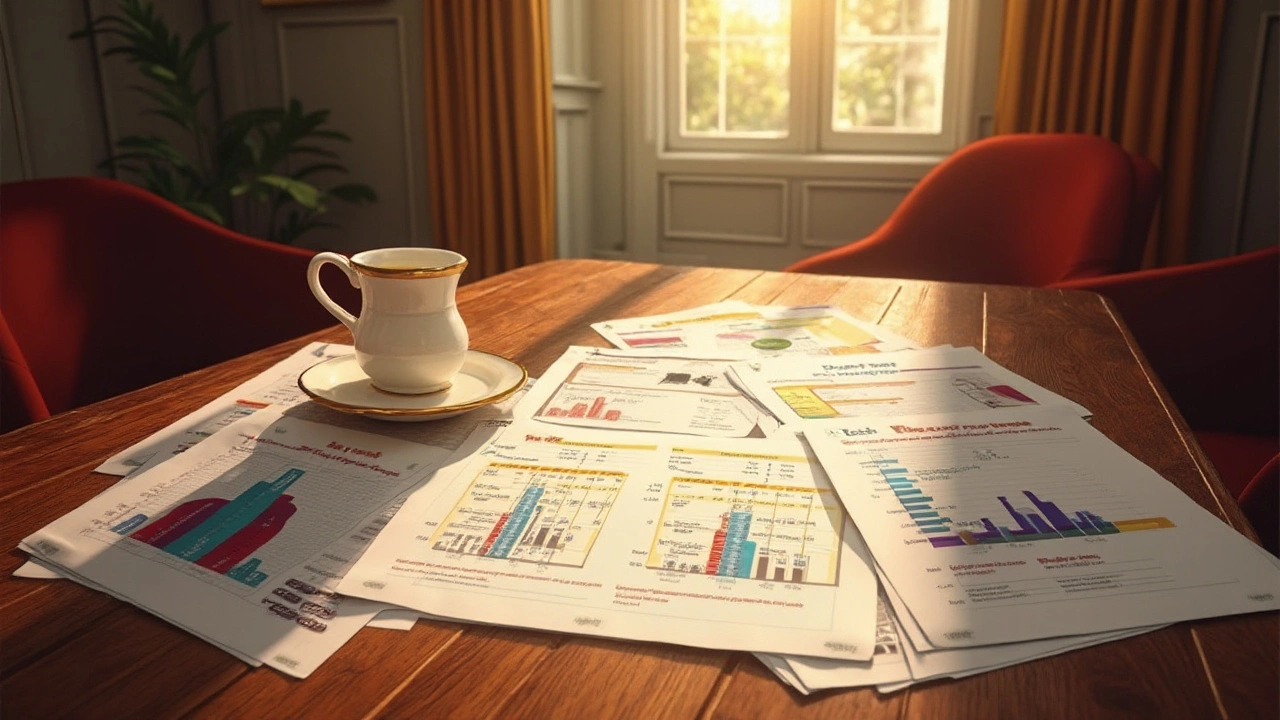Facing $60,000 in debt might seem like a mountainous task, but with the right approach, climbing to financial freedom is possible. It's about creating a roadmap that leads you out of debt quicker than you'd think. In this article, we'll explore effective strategies and tips that can help lighten the burden on your shoulders.
From understanding the nuances of your debt to smart consolidation options, there's a plan waiting for you. It's about making informed choices that work for your specific situation, and being equipped with the knowledge to turn the tide. So take a deep breath, and let's delve into how you can regain control over your finances.
- Understanding Your Debt
- Exploring Debt Consolidation Options
- Creating a Realistic Budget
- Living with Less: Frugality Tips
- Increasing Your Income
Understanding Your Debt
In the journey to pay off any large debt, the first and foremost step is to fully comprehend the nature of your debt. Knowing exactly what you're dealing with can make the journey less overwhelming and more structured. Dive into the details of the debt, which might involve several types, including credit card balances, student loans, personal loans, or mortgage payments. Each type of debt carries its terms, interest rates, and repayment schedules, which can affect your strategy for paying it off.
A key point to start with is checking your credit report. Your report will provide you with a detailed list of all your debts, the loyalty of your payments, and your credit score. You can access your credit report for free from the major credit bureaus. This step is crucial as it provides a clear snapshot of where you stand and helps you verify that all recorded transactions are accurate.
From this point, you can move on to categorizing your debts into 'good' and 'bad'. While it might sound strange, not all debt is inherently bad. 'Good debt', like student loans or mortgages, often comes with lower interest rates and potential tax benefits, whereas 'bad debt', typically associated with high-interest rates like those on credit cards, tends to be more costly over time.
The next critical step when understanding your debt is to calculate the total amount owed precisely. Knowing the big number you're up against is both scary and empowering. Record the minimum monthly payment requirements, the interest rates, and the remaining balance for each debt. This will be your guiding path as you consider how much you can feasibly pay off on a monthly or even weekly basis.
Debt-to-Income Ratio
Your debt-to-income ratio (DTI) is a significant factor lenders consider before offering you more credit. It is the measurement of how much of your income is used to service debts every month. To calculate your DTI, add up all your monthly debt payments and divide them by your gross monthly income. If your DTI is above 20% for non-mortgage debt, you might be stretched thin, making consolidating and paying off debt a priority.
"Consumer debt often is the product of temptations in modern society," says Elizabeth Warren, a respected advocate for consumer rights. This quote serves as a reminder that spending beyond our means can lead to a challenging cycle of debt.
Understanding the intricacies of each debt type, alongside strategic planning that includes consistently updating your financial status and DTI, can set a solid foundation for paying off $60,000 or any large sum. This level of comprehension allows you to move forward with confidence as you tackle each debt one by one.
Exploring Debt Consolidation Options
Confronted with the weight of a $60,000 debt, it’s essential to understand that various debt consolidation options can be the key to simplifying your financial obligations. By merging multiple debts into a single payment with potentially lower interest rates, debt consolidation can give you a sense of control and clarity. One popular method is a debt consolidation loan, typically unsecured, allowing you to pay off your existing debts immediately while focusing on a single lender. It’s crucial to research terms and compare interest rates from different lenders to find the best deal that aligns with your financial health. In another form, balance transfer credit cards offer a promotional period with zero or low interest, which can be beneficial if used wisely. Remember, it's essential to clear the balance before the promotional period expires to avoid high rates reapplying.
Home equity loans and lines of credit also provide avenues to consolidate debt, leveraging your home as collateral. This route can offer significantly lower interest rates compared to unsecured options but comes with the caveat of risking your home should you default. Caution and sound financial planning should accompany any decision-making process. For those who feel overwhelmed, seeking out nonprofit credit counseling agencies can help. They provide valuable services, like debt management plans, where the agency negotiates with your creditors for reduced payments in exchange for closing accounts. Bear in mind, these agencies often charge a monthly fee for their services, which should be factored into your budgeting plans.
"More than 70% of people who consolidate debt report a positive impact on their credit score within a year," says esteemed financial advisor Jane Moore.
Debt consolidation isn't a one-size-fits-all; each option has unique pros and cons that must be evaluated based on individual circumstances. It's vital to be realistic about your current financial situation and future goals. Prioritize options that offer you the flexibility to pay off your debt while enhancing your financial discipline. Here’s a quick guide on evaluating options: Begin by assessing your debt’s total amount, interest rates, and monthly payments. Use this information to calculate the potential benefit of consolidation. For those considering working with a debt consolidation company, regulatory consumer protection agencies like the Consumer Financial Protection Bureau offer resources to evaluate the trustworthiness and reliability of such services. Their information can help steer you clear of potential scams.
Beyond understanding the logistics, emotional readiness plays a role in your debt payoff journey. Tackling debt consolidation can also mean adjusting spending habits to ensure you don’t accrue more debt. Embrace a long-term view, understanding that consolidating debt is a step, not a solution, toward financial freedom. Reinforce your commitment to budgeting, saving, and spending wisely to cement the benefits accrued from consolidating your debt.

Creating a Realistic Budget
Building a budget is often the cornerstone of any successful debt repayment plan. It's not just about crunching numbers, but crafting a clear view of your financial landscape. The goal here is to understand where your money is going and how you can redirect it more effectively to tackle your debt head-on. Begin by listing all your income sources and monthly expenses. This includes fixed expenses such as rent, utilities, and loan payments, as well as variable costs like groceries and entertainment.
Start by tracking your spending for an entire month. This doesn't just mean keeping receipts, but actively noting every penny that leaves your pocket. You'll likely be surprised by certain categories, such as dining out or impulsive online shopping. Apps like Mint or YNAB (You Need a Budget) can be particularly helpful in breaking down expenses. The aim is to reveal spending habits and find the areas where you can cut back in order to free up money for debt payments. As Benjamin Franklin famously said,
"Beware of little expenses; a small leak will sink a great ship."His timeless advice applies fittingly to the trickling expenses that often go unnoticed.
Once you have a good grasp of your monthly financial activity, it's time to allocate your income more wisely. Employing the 50/30/20 rule can serve as a rough guideline. It suggests using 50% of your income for needs, 30% for wants, and 20% for debt repayment and savings. Given your current $60,000 debt situation, you might consider tweaking this ratio, perhaps directing a larger slice towards the debt payments. Remember, each cent counts in the grand scheme of things.
To avoid slipping back into past patterns, be sure to revisit and adjust your budget regularly. Changes in your income or expenses, even small ones, should reflect in your budget. This dynamic approach helps maintain a realistic and effective plan. It's also crucial to set realistic milestones along the way. Rather than focusing solely on the total sum, break it down into manageable chunks. For example, set a target to pay off $5,000 in a certain number of months. Celebrating these little victories boosts morale and keeps you motivated.
Putting Your Plan Into Action
Now that your budget is structured, it's time to act. Prioritize debts with the highest interest rates first, as those accumulate quicker, and cost you more money in the long term. This strategy is known as the avalanche method. Alternatively, some prefer the snowball method, which targets smaller debts to gain a sense of early accomplishment. Whichever you choose, consistency is key.
Monitor your progress regularly, and don't be discouraged by minor setbacks. Economic fluctuations or unexpected expenses could force you to recalibrate. Try to maintain an emergency fund for such situations; even a small safety net can prevent financial panic and piling on more debt. Remember, budgeting is not a one-time task but a continuous journey.
Keep in mind that the primary objective is not just to eliminate debt but to gain financial freedom and peace of mind. As daunting as a $60,000 debt may seem, with diligent budgeting and determination, it's possible to turn the tide. Budgeting is more than just math; it's a lifestyle change that empowers you to control your financial destiny.
Living with Less: Frugality Tips
Embracing a lifestyle of frugality doesn't mean deprivation; rather, it's about making choices that align closely with your financial goals in the journey of getting rid of that hefty $60,000 debt. It's surprising how much money can be saved with small changes. You can start by examining your day-to-day expenses and finding alternatives to the non-essentials. Coffee from your local barista might seem like a small luxury, but brewing your own could save hundreds annually. Similarly, cutting back on dining out and opting for homemade meals can have a profound impact on your budget without sacrificing flavor or satisfaction.
Take a look around your home and assess what's truly necessary. The modern household is often cluttered with items that provide little value. Adopting a minimalist philosophy can significantly cut costs. Consider selling items not used within the past year, which not only declutters your space but can provide a cash influx to apply directly to your debt. Emphasize energy conservation as well; shift to LED bulbs, unplug appliances when not in use, and be mindful of heating and cooling costs. These seemingly minor adjustments can result in lower utility bills, allowing those savings to contribute to debt repayment.
"A penny saved is a penny earned," said Benjamin Franklin, emphasizing the importance of small, mindful savings that accumulate into considerable sums over time.
Reassessing your transportation needs is another area ripe for potential savings. If your daily commute involves a vehicle, consider alternatives such as public transit, carpooling, or even biking if feasible. These alternatives can significantly reduce your gasoline and maintenance expenses. Moreover, some may find that renegotiating their utility or subscription services yields extra funds. In today's competitive markets, companies are often willing to lower rates to retain customers – don't hesitate to ask.
Implementing a disciplined budgeting approach plays a pivotal role in your frugality efforts. Allocate specific amounts to categories like groceries, transportation, and entertainment, keeping in mind the ultimate aim—to direct more funds toward debt. Stick closely to these limits, but be prepared to adjust as you identify patterns in your spending habits. Where possible, automate savings to ensure you're consistently setting aside money to minimize temptation.
| Expense Area | Potential Savings per Year |
|---|---|
| Coffee at Home | $500 |
| Homemade Meals | $1,200 |
| Energy Efficiency | $300 |
| Transport Alternatives | $600 |
As you continue to practice living on less, remember that frugality is about sustainability and making gradual changes that build toward a financially stable future. By adopting these habits, you not only move closer to alleviating your debt but also cultivate a lifestyle that can lead to ongoing financial freedom. Every dollar saved is one step closer to breaking free from the chains of debt and living the life you've envisioned.

Increasing Your Income
When it comes to tackling $60,000 in debt, boosting your income is one of the most effective strategies. It’s not just about cutting back; sometimes, adding more cash flow into your life is the better solution. Think of it as a two-pronged approach: trim where you can and grow your financial opportunities. One of the simplest ways to increase income is by looking into side gigs that align with your skills or interests. Whether it’s freelancing in your field, selling handcrafted items, or offering services like dog walking, every extra dollar can make a difference.
Technological advancements have also paved the way for numerous online job platforms. Websites such as Upwork, Fiverr, or TaskRabbit connect individuals with clients looking for everything from graphic design to errands. Moreover, the gig economy offers flexibility, allowing you to work around your full-time job without compromising it. There is an ever-growing demand for ride-share drivers or delivery personnel with companies like Uber, Lyft, and DoorDash. These options allow you to work when you want and can be a great way to generate extra income without significant ongoing commitments.
Investing your time in developing new skills can also raise your income potential significantly. As per the U.S. Bureau of Labor Statistics, occupations requiring more than high-school education are projected to grow by 7.7% from 2019 to 2029, which is higher than the national average for all occupations. Consider online courses or certificates that align with future job trends. Platforms like Coursera or Udemy offer education in various fields like coding or digital marketing, making it possible to learn and adapt without the need for a traditional college route.
The famed financial advisor, Suze Orman, once said, "If you’re in debt, the first thing you need to do is stop digging – then find ways to climb out." Increasing your income is indeed a significant step in building a sturdy ladder to financial recovery.Landlords with extra space might look into renting out a portion of their property. Services like Airbnb make it easy to turn spare rooms into profit-generating assets. However, be sure to check local ordinances or homeowner association rules concerning short-term rentals to avoid unnecessary fines.
Another creative way to secure more cash flow is by monetizing your hobbies or talents. Are you good at photography, art, or playing a musical instrument? Offering lessons or workshops can be an appreciated service in your community. Not only will it bring in money, but it will also nurture your passions. Alternatively, if you’re familiar with the world of gaming or YouTube, creating content can eventually yield profits through ads and sponsorships once you build a following. Influencer marketing has become a billion-dollar industry and tapping into niche areas can be quite profitable.
Ponder these approaches in a manner that best suits your lifestyle and goals. Remember, the objective isn’t to burn out, but rather to open pathways to improvement. By strategically increasing your income, the path to paying off debt becomes more accessible, setting the stage for a financially free future where you have more control over your circumstances.
